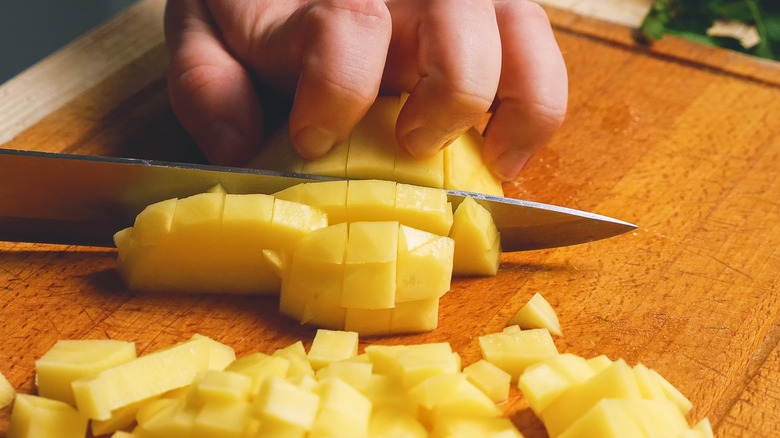The Ideal Way To Cut Potatoes For Blended Soup
What's more wholesomely satisfying than a bowl of hearty soup? Nothing, really. And the secret to almost any hearty soup? Potatoes. From a light and creamy cauliflower potato soup to a thick and flavorful roast potato and sweet corn chowder, potatoes can be the star of your soup. The key is to properly dice and blend them. Blending part of a potato soup's chunky ingredients not only gives it an added element of creaminess; it also ensures a satisfyingly thick consistency. Be careful, though, because too much blending can turn your soup into potato slime.
Commonly known as root vegetables, potatoes are actually edible root tubers, and when boiled, those tubers release lots of starch. The high starch content of potatoes makes them natural thickening and binding agents for savory, vegetable dishes, especially when the meal calls for lots of liquid, as in the case of soup. For the best blending result, dice your potatoes into small cubes, shooting for even sizes. We're looking for the Yukon-Goldilocks of knife cuts: not so fine that thin slices of potato disintegrate in the broth, but not so chunky that the middles don't get tender enough when cooked. Aim for cubes no thicker than ¾ inch.
Potato soup that makes the cut
There's just something special about lovingly tending to a pot of soup as it simmers on the stove, particularly when it contains delicious potatoes. While you should be careful not to overwork the starch in mashed potatoes, soups require different methods. Potato dishes without an excess of moisture should be fluffy, whereas the broth and cream bases of soups need to soak up that extra stickiness of starch to reach the desired texture.
Pulverizing potatoes can make them gummy or gluey, but cut them to the right size and shape, add lots of liquid, and presto, those spuds magically become an excellent thickener. But before you go dumping your whole pot of soup into the blender, let's brush up on the dos and don'ts of working with your diced potatoes. First, start with extra starchy varieties like russet or Yukon gold. After peeling, cube the potatoes into small, even pieces between ½ to ¾ inch thick, and simmer them in the soup pot with fats and aromatics.
Don't fill the whole pot with broth yet — just let the potatoes and other veggies cook. After they've softened appropriately, add the broth and cream. Now, either use an immersion blender to gently blend the soup, or blend small batches in a blender or food processor using quick pulses to avoid overworking the starch. Once you garnish it with cheese, scallions, or any other garnishes you crave, grab a spoon and enjoy your soup!

